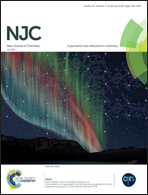SnCl2-catalyzed synthesis of dihydro-5H-benzo[f]pyrazolo[3,4-b]quinoline and dihydroindeno[2,1-b]pyrazolo[4,3-e]pyridine with high fluorescence and their photophysical properties†
Abstract
A series of high-performance chromophores, namely pyrazoloquinoline- and pyrazolopyridine-based derivatives bearing donor–acceptor (D–A) substituent groups on the phenyl ring, was synthesized by a mild reaction. Photophysical studies, including spectral analysis and single crystal X-ray diffraction, were conducted in order to investigate how the substituent affects the solution and examine the solid-state optical properties of the derivatives. Pyrazoloquinoline derivatives exhibited redshifted absorption, emission maxima wavelengths, and higher Stokes shift values than the corresponding pyrazolopyridine derivatives in chloroform. The dimethylamino-substituted derivatives displayed aggregation induced emission (AIE) and also positive solvatochromism in the fluorescence spectrum, which was due to a more polarized, excited state than the ground state. Noticeable acidochromism was observed for the dimethylamino-substituted group in acetonitrile solvent due to the addition of trifluoroacetic acid, which induced protonation at the pyridine segment and enhanced blueshifted emission.
![Graphical abstract: SnCl2-catalyzed synthesis of dihydro-5H-benzo[f]pyrazolo[3,4-b]quinoline and dihydroindeno[2,1-b]pyrazolo[4,3-e]pyridine with high fluorescence and their photophysical properties](/en/Image/Get?imageInfo.ImageType=GA&imageInfo.ImageIdentifier.ManuscriptID=C7NJ03654J&imageInfo.ImageIdentifier.Year=2018)


 Please wait while we load your content...
Please wait while we load your content...